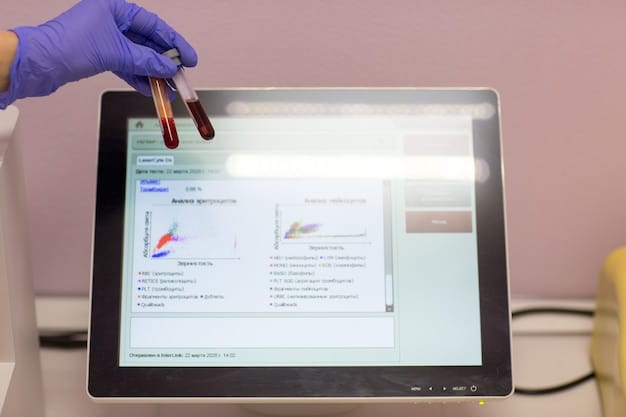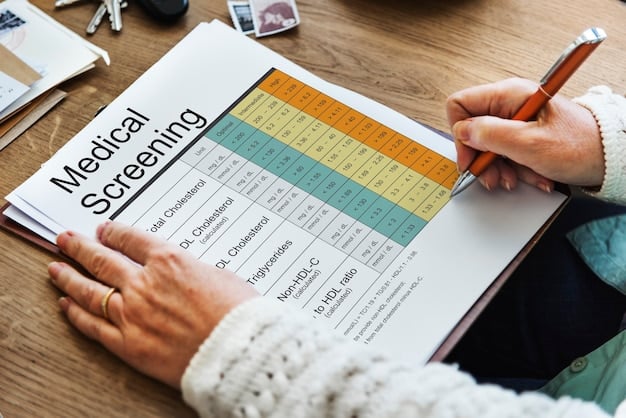Biotech Clinical Trial Data: A Guide to Smart Investing

Biotech clinical trial data analysis is crucial for informed investment decisions, involving understanding trial phases, statistical significance, and potential risks to effectively evaluate a company’s prospects.
Investing in biotech requires a keen understanding of clinical trial data. This guide will equip you with the knowledge to navigate this complex landscape and make informed investment decisions.
Understanding Biotech Clinical Trial Phases and Their Significance
Biotech companies rely heavily on clinical trials to prove the safety and efficacy of their new drugs or therapies. These trials are divided into distinct phases, each serving a specific purpose in the drug development process.
Understanding these phases is critical for investors, as progress from one phase to the next significantly impacts a company’s valuation and prospects.
Phase 0: Exploratory Studies
Phase 0 trials are the earliest and smallest trials, often involving only a few participants. The primary goal is to determine if the drug behaves in the body as expected based on preclinical studies.
Phase 1: Safety and Dosage
Phase 1 trials focus on assessing the safety and tolerability of the drug in a small group of healthy volunteers. Researchers are looking for potential side effects and determining the appropriate dosage range.
- Evaluating toxicity and side effects.
- Determining the safe dosage range.
- Identifying how the drug is absorbed, distributed, metabolized, and excreted.

Phase 1 data provides initial insights into the drug’s pharmacokinetic and pharmacodynamic properties, setting the stage for further studies.
Interpreting Statistical Significance in Clinical Trial Results
A statistically significant result indicates that the observed effect of a drug is unlikely to have occurred by chance. This is a crucial concept in clinical trial data analysis, and investors must understand how to interpret it.
P-values and confidence intervals are the two most common measures used to assess statistical significance.
Understanding P-Values
The p-value is the probability of obtaining results as extreme as, or more extreme than, the observed results, assuming that the null hypothesis is true. In simpler terms, it tells us the likelihood that the observed effect is due to random chance.
Confidence Intervals
A confidence interval provides a range of values within which the true effect of the drug is likely to lie. A 95% confidence interval, for example, means that we are 95% confident that the true effect falls within the specified range.
Statistical significance is a vital factor in evaluating clinical trial data, signaling the reliability of findings and influencing investment decisions in the biotech sector.
Analyzing Endpoints: Primary, Secondary, and Surrogate
Endpoints are the events or outcomes that are measured in a clinical trial to assess the effectiveness of a treatment. Understanding the different types of endpoints is essential for evaluating the trial’s results.
There are three main types of endpoints: primary, secondary, and surrogate.
Primary Endpoints
The primary endpoint is the main outcome that the trial is designed to measure. It is pre-specified in the study protocol and is the most important factor in determining whether the trial is successful.
Secondary Endpoints
Secondary endpoints are additional outcomes that are measured in the trial, but are not the primary focus. They can provide valuable insights into the drug’s effects, but are not as critical as the primary endpoint.
- Providing additional data on the drug’s effects.
- Supporting the findings of the primary endpoint.
- Offering insights into potential safety concerns.
Careful evaluation of endpoints, including primary, secondary, and surrogate markers, aids in a comprehensive understanding of the treatment’s impact and informs decision-making in biotech investments.
Evaluating Safety Data and Adverse Events
Evaluating the safety data from clinical trials is just as critical as assessing efficacy. Investors need to be aware of potential adverse events and how they might impact the drug’s approval and market potential.
Adverse events are any undesirable experiences associated with the use of a drug. They can range from mild side effects, such as nausea or headache, to more serious events, such as organ damage or death.
Understanding Adverse Event Reporting
Adverse events are typically reported as the number and percentage of participants who experienced a particular event in each treatment group. It is essential to compare the incidence of adverse events in the treatment group to the placebo group.
Assessing the Severity of Adverse Events
Adverse events are often categorized by severity, such as mild, moderate, or severe. Severe adverse events are those that are life-threatening, require hospitalization, or result in significant disability.

A comprehensive assessment of safety data and adverse events is crucial, as it helps investors understand potential risks and make informed decisions regarding biotech investments.
Considering the Patient Population and Trial Design
The patient population and trial design can significantly influence the results of a clinical trial. Investors should carefully consider these factors when evaluating the data.
Key aspects to consider include patient demographics, disease stage, and the presence of other medical conditions.
Patient Demographics
The characteristics of the participants in a clinical trial, such as age, sex, race, and ethnicity, can influence the drug’s effects. It is essential to ensure that the patient population is representative of the population that the drug is intended to treat.
Trial Design Elements
Different clinical trial designs, such as randomized controlled trials, open-label trials, and single-arm trials, can impact the interpretation of the results. Randomized controlled trials are generally considered the gold standard, as they minimize bias.
Careful consideration of the patient population and trial design is essential for interpreting the results accurately, enabling investors to make well-informed decisions, especially in biotech investments.
Making Informed Investment Decisions Based on Trial Data
Ultimately, the goal of analyzing biotech clinical trial data is to make informed investment decisions. This requires a comprehensive assessment of all the factors discussed above, as well as an understanding of a company’s overall financial position and market potential.
It’s important to consider the entire picture, not just one single data point.
Assessing the Risk-Reward Profile
Investing in biotech is inherently risky, as many drugs fail to make it through clinical trials. However, the potential rewards can be significant if a drug is successful.
Diversifying Your Portfolio
To mitigate risk, it is advisable to diversify your biotech investment portfolio across multiple companies and therapeutic areas.
Analyzing biotech clinical trial data to make informed investment decisions involves assessing the risk-reward profile, diversifying your portfolio, and considering all factors to ensure wise conclusions.
| Key Point | Brief Description |
|---|---|
| 🔬 Trial Phases | Understand Phase 1-3 goals to assess drug development progress. |
| 📈 Statistical Significance | Analyze p-values and confidence intervals to ensure results are reliable. |
| ⚠️ Safety Data | Evaluate adverse events and their severity for potential risks. |
| 👥 Patient Population | Consider demographics to ensure results apply to the target group. |
FAQ
▼
A successful Phase 2 trial typically shows statistically significant efficacy in the target patient population, a manageable safety profile, and clear evidence that the drug is working as expected.
▼
A low p-value (typically less than 0.05) suggests that the observed results are unlikely to be due to chance, indicating a statistically significant effect of the treatment being studied.
▼
Surrogate endpoints are used as substitutes for direct measures of clinical benefit. They provide early indications of efficacy but should be validated against actual patient outcomes.
▼
Patient diversity ensures that clinical trial results are generalizable to a broader population, accounting for potential differences in drug response based on factors like genetics and ethnicity.
▼
Red flags in safety data include a high incidence of severe adverse events, significant differences in adverse events between the treatment and placebo groups, and unexpected or unexplained safety signals.
Conclusion
Analyzing biotech clinical trial data is a critical skill for investors looking to capitalize on the potential of groundbreaking therapies. By understanding the nuances of trial phases, statistical significance, endpoints, and safety data, investors can make more informed decisions and navigate the complexities of biotech investing with greater confidence.





